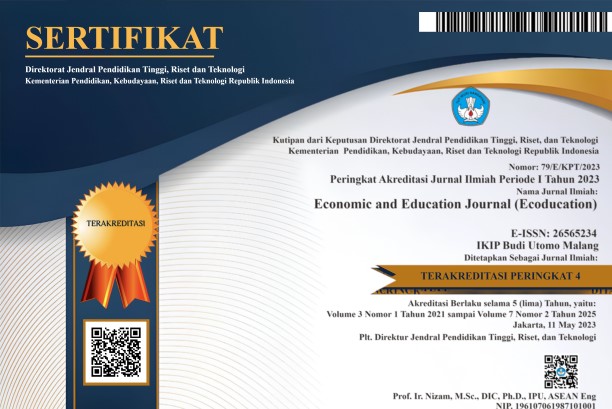Social and Economic Conditions on Children's Education Level Fisherman Family in Nangadhero Village, Aesesa District Nagekeo District
Abstract
Social and economic conditions of parents in the family which will affect the education received by children, seen from the level of parental education, parents' age, income, expenses and even environmental factors can also affect the level of education of a child. The research aims to find out how much influence social and economic conditions have on the level of education of children of fishermen families in Nangadhero village, Aesesa District, Nagekeo Regency, using the Ex-post facto method. The sample was 83 family heads from a total population of 105 families who work as fishermen. Data collection techniques using questionnaires and documentation, the results of research (1) There is a significant influence between social conditions on the level of education of fishermen children, with a tcount of 2.113> 1.667, and significant = 0.038 <0.05. (2) There is no significant influence between economic conditions on the education level of fishermen children, with a significant value> 0.05. (3) There is an influence of 10.2% between social conditions and economic conditions simultaneously on the educational level of children of fishermen families in Nangadhero village, Aesesa District, Nagekeo Regency.
References
Widyowati, Dyah (2017) TINGKAT KETERCAPAIAN CAPAIAN PEMBELAJARAN MELALUI KESIAPAN MAHASISWA MENGIKUTI UJIAN KOMPETENSI PADA PROGRAM STUDI MANAJEMEN PERKANTORAN UNIVERSITAS AIRLANGGA. Jurnal Bisnis Teknologi, 4 (1). pp. 1-7. ISSN 2355-8865
Febriana, S. W., & Rohmah, W. (2007). Pengaruh Kondisi Sosial Ekonomi Orang Tua Terhadap Prestasi Belajar Geografi Siswa Kelas Viii Smp N 1 Randudongkal Kabupaten Pemalang Tahun 2006/2007. 23.
Kadriani, Faraag Ahmed H, EI-Batal Ahmed I, E.-H. H. H. (2017). PERSEPSI MASYARAKAT NELAYAN TENTANG PENTINGNYA PENDIDIKAN FORMAL DI DESA JAWI-JAWI KECAMATAN BUNGKU SELATAN KABUPATEN MOROWALI. Nature and Science, 15(5), 55–68. https://doi.org/10.1360/N972017-00542
Kamaludin, A. (2019). HUBUNGAN KUALITAS PELAYANAN TERHADAP KEPUASAN KONSUMEN PADA APOTIK PUJI LESTARI MAJALENGKA. Jurnal Ilmiah Indonesia, 4(12), 47–55.
Rosni, R. (2017). Analisis Tingkat Kesejahteraan Masyarakat Nelayan Di Desa Dahari Selebar Kecamatan Talawi Kabupaten Batubara. Jurnal Geografi, 9(1), 53. https://doi.org/10.24114/jg.v9i1.6038
Rosmaladewi. (2020). Analisis sosial ekonomi komunitas nelayan danau tempe kabupaten wajo. 2(1), 48–61.
Sugiyono. (2017). Metode Penelitian Pendidikan Pendekatan Kuantitatif, Kualitatif, dan R&D. Bandung: Alfabeta.
Sumintarsih. (2005). Kearifan lokal di lingkungan masyarakat nelayan Madura. Balai Kajian Sejarah dan Nilai Tradisional, Deputi Bidang Pelestarian dan Pengembangan Kebudayaan, Kementerian Kebudayaan dan Pariwisata.
Siti, N. S. S. (2016). Kesadaran Masyarakat Nelayan terhadap Pendidikan Anak. JPPUMA: Jurnal Ilmu Pemerintahan Dan Sosial Politik UMA (Journal of Governance and Political Social UMA), 4(1), 1–10.
Pritandhari, M. (2016). PENERAPAN KOMIK STRIP SEBAGAI MEDIA PEMBELAJARAN MATA KULIAH MANAJEMEN KEUANGAN MAHASISWA UNIVERSITAS MUHAMMADIYAH METRO. Jurnal Program Studi Pendidikan Ekonomi, 4(2). E-ISSN: 2442-9449. DOI: http://dx.doi.org/10.24127/ja.v4i2.631
















